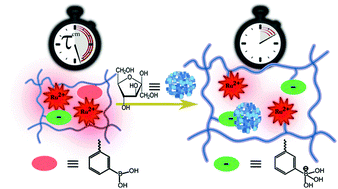Sugar-responsive microgels were prepared by the covalent grafting of a poly(N-isopropylacrylamide) (pNIPAM) matrix with phenylboronic acid (PBA) as a saccharide sensing unit and a [Ru(bpy)3]2+ derivative (2,2′-bipyridine) as a luminescent reporter. Time-resolved emission studies reveal that the ruthenium complex has an unusually long lifetime (1.6 μs) and high quantum yield (∼0.17) in the PBA-microgel environment. In the presence of sugars, the microgels swell due to the formation of a sugar–boronate ester, leading to a more hydrophilic polymer chain. The swelling is accompanied by a decrease of the lifetime and the photoluminescence quantum yield, which cannot be explained solely by the swelling of the hydrogel. The emission properties of the ruthenium complex in PBA-functionalized microgels are compared to those in pNIPAM microgels lacking PBA moieties in various swelling states. The presence of PBA in the vicinity of [Ru(bpy)3]2+ is shown to have a predominant impact on its luminescence properties, mainly through a decrease of the polarity. Sugar-induced triggering of the boronate state thus leads to strong variations of the polarity and the luminescence characteristics.

